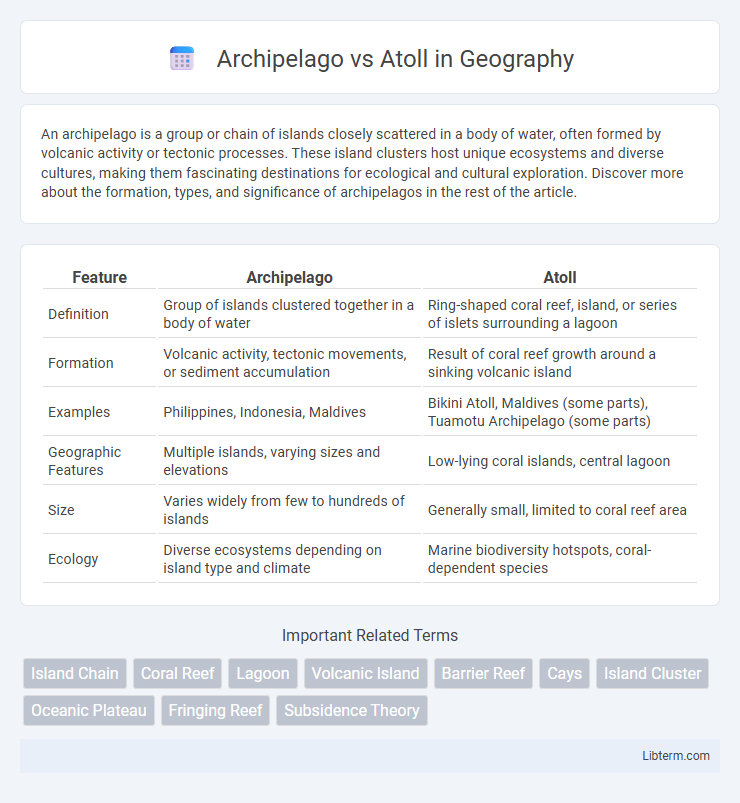An archipelago is a group or chain of islands closely scattered in a body of water, often formed by volcanic activity or tectonic processes. These island clusters host unique ecosystems and diverse cultures, making them fascinating destinations for ecological and cultural exploration. Discover more about the formation, types, and significance of archipelagos in the rest of the article.
Table of Comparison
| Feature | Archipelago | Atoll |
|---|---|---|
| Definition | Group of islands clustered together in a body of water | Ring-shaped coral reef, island, or series of islets surrounding a lagoon |
| Formation | Volcanic activity, tectonic movements, or sediment accumulation | Result of coral reef growth around a sinking volcanic island |
| Examples | Philippines, Indonesia, Maldives | Bikini Atoll, Maldives (some parts), Tuamotu Archipelago (some parts) |
| Geographic Features | Multiple islands, varying sizes and elevations | Low-lying coral islands, central lagoon |
| Size | Varies widely from few to hundreds of islands | Generally small, limited to coral reef area |
| Ecology | Diverse ecosystems depending on island type and climate | Marine biodiversity hotspots, coral-dependent species |
Definition: What is an Archipelago?
An archipelago is a group or chain of islands clustered together in a sea or ocean, typically formed by volcanic activity or tectonic processes. These islands vary in size and can be composed of different rock types, creating diverse ecosystems and habitats. Archipelagos are significant geographic formations often found along continental margins or oceanic hotspots.
Definition: What is an Atoll?
An atoll is a ring-shaped coral reef, island, or series of islets surrounding a lagoon, formed from the growth of coral reefs around a sinking volcanic island. Unlike an archipelago, which is a group or chain of islands clustered together, an atoll specifically features a central lagoon encircled by coral formations. The unique ecosystem of an atoll supports diverse marine life adapted to shallow, warm waters.
Formation Processes of Archipelagos
Archipelagos form primarily through tectonic plate movements, volcanic activity, and erosion, creating clusters of islands over time. Volcanic archipelagos arise as magma breaches the Earth's crust, cooling and solidifying into islands, as seen in the Hawaiian Islands. Tectonic activity also shapes archipelagos by uplifting land or causing fractures that isolate portions of land, contrasting with atolls formed from coral reef growth around sunken volcanic islands.
Formation Processes of Atolls
Atolls form through the subsidence of volcanic islands combined with coral reef growth, where coral reefs develop around a sinking volcanic island, eventually leaving a ring-shaped reef enclosing a lagoon after the island erodes away. This process involves a coral framework built on the volcanic base that keeps pace with sea level changes and island subsidence over thousands to millions of years. In contrast, archipelagos consist of multiple islands that are geographically close but formed through various geological processes such as volcanic activity, tectonic shifts, or erosion without the exclusive coral reef development characteristic of atolls.
Key Geographic Differences
An archipelago is a group or chain of multiple islands clustered together in a body of water, often varying in size and geological origin, while an atoll is a specific type of island formed from a coral reef surrounding a lagoon, typically circular or ring-shaped. Archipelagos can consist of volcanic, continental, or coral islands scattered unevenly, whereas atolls emerge from subsiding volcanic islands where coral growth maintains the reef structure. Key geographic differences include the formation process, physical shape, and ecological environment, with archipelagos offering diverse landforms and atolls characterized by their coral reef ecosystems.
Ecological Significance of Archipelagos and Atolls
Archipelagos and atolls both support unique ecosystems critical for biodiversity conservation, with archipelagos often harboring diverse terrestrial habitats and endemic species due to their multiple islands and varied environments. Atolls provide essential marine habitats, including coral reefs that serve as nurseries for numerous fish species and protect coastlines from erosion and storms. The ecological significance of these formations lies in their roles as biodiversity hotspots, sources of genetic diversity, and natural buffers against climate impacts.
Famous Examples Around the World
The Maldives is a renowned example of an atoll, featuring ring-shaped coral reefs surrounding lagoons and numerous small islands. The Philippine archipelago, consisting of over 7,000 islands, stands as one of the world's largest and most diverse island groups. The Hawaiian Islands illustrate a volcanic archipelago with distinct individual islands formed by tectonic activity and hotspots in the Pacific Ocean.
Human Settlements and Cultural Impact
Human settlements on archipelagos often benefit from diverse resources and strategic trade routes, fostering multicultural communities with rich traditions linked to fishing, navigation, and agriculture. Atolls, characterized by their ring-shaped coral formation and limited landmass, support smaller populations that develop unique cultural practices adapted to scarce freshwater and marine resource reliance. Both landforms influence cultural identity, with archipelagos encouraging broader cultural exchange and atolls nurturing closely-knit societies centered around lagoon ecosystems.
Environmental Challenges and Conservation
Archipelagos and atolls face distinct environmental challenges influencing conservation strategies; archipelagos often struggle with biodiversity loss due to habitat fragmentation, invasive species, and human activities, whereas atolls confront rising sea levels and coral bleaching intensified by climate change. Conservation efforts in archipelagos prioritize protecting endemic species and managing inter-island ecological connectivity, while atoll conservation emphasizes coral reef restoration, shoreline stabilization, and sustainable resource use to combat erosion and habitat degradation. Effective environmental management requires tailored approaches reflecting the unique geological and ecological contexts of archipelagos and atolls to preserve their biodiversity and ecosystem services.
Choosing Between Archipelago and Atoll: Which Term to Use?
Choosing between "archipelago" and "atoll" depends on the geographic context and specific landform characteristics. Use "archipelago" when referring to a group or chain of islands clustered together, often volcanic or continental in origin. Opt for "atoll" when describing a ring-shaped coral reef or island surrounding a lagoon, typically found in tropical ocean waters.
Archipelago Infographic

 libterm.com
libterm.com